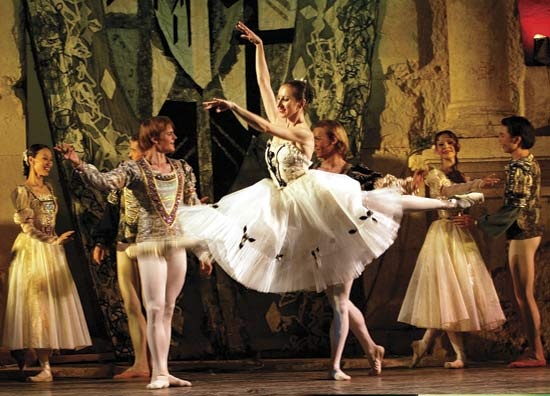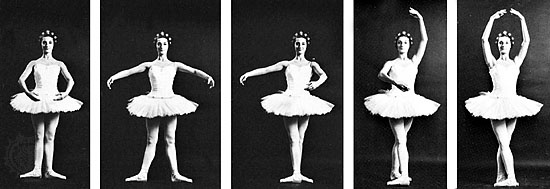ballet
dance
 theatrical dance in which a formal academic dance technique—the danse d'école—is combined with other artistic elements such as music, costume, and stage scenery. The academic technique itself is also known as ballet.
theatrical dance in which a formal academic dance technique—the danse d'école—is combined with other artistic elements such as music, costume, and stage scenery. The academic technique itself is also known as ballet.Ballet developed out of the court spectacles of the Renaissance and the subsequent French ballet de cour, in which social dances performed by royalty and aristocracy were presented in harmony with music, speech, verse, song, pageant, decor, and costume. After some years of decline in dance standards in the 17th century, Louis XIV of France (1638–1715), a great devotee of dancing himself, in his concern to “reestablish the dance in its true perfection,” established the Académie Royale de Danse (Paris Opéra Ballet) in 1661—the same year in which was presented the first comédie-ballet (with text by Molière and music by Jean-Baptiste Lully (Lully, Jean-Baptiste)), in which dances were separated by scenes of a play. In due course, this led to Lully's opéra-ballets and the establishment of a school to train professional dancers for them, attached to the Académie Royale de Musique (or the Opéra). The new professionals were trained in dance as a mirror of noble deportment and manners. With the guidance of Lully and the ballet master Pierre Beauchamps (1631–1719), ballet emerged as a theatrical form.
The century that followed saw great advances in technical standards of ballet dancing and a new concern with ballet as a vehicle of drama. In the latter, Jean-Georges Noverre (Noverre, Jean-Georges) was central: his Lettres sur la danse et les ballets (1760; Letters on Dancing and Ballets) was a major influence throughout Europe on the development of the ballet d'action, or dramatic ballet, in which the dancers' movements were designed to express character and to assist in the narrative. At the same time, the composer Christoph Gluck (Gluck, Christoph Willibald), in both opera and ballet, brought fresh vigour and drama to dance accompaniment. This was also the era of the three genres: According to physique, dancers were trained in different techniques—noble, or sérieux; demi-caractère; and comique, or grotesque. Thus stratified, ballet became a grand theatrical form like opera, performed in opera houses, as often it still is today; many operas contained ballet divertissements (suites of ballet numbers used as interludes).
 Ballet of that time still reflected aristocratic attitudes, but the industrial, social, political, and artistic revolutions of the late 18th and early 19th centuries brought great alterations. Especially in France, which was the centre of style in ballet teaching, the ancien régime and its social dances ceased to be a model for dancers. The stage dancing of the early 19th century was given new artistic purpose in the Romantic ballet (classical ballet), particularly with the dancing of Marie Taglioni (Taglioni, Marie) and Fanny Elssler (Elssler, Fanny). With the introduction of pointework (position of balance on extreme tip of toe) to the dance vocabulary, the ballerina became a supreme or ideal stage figure. Scenarios for ballets began to be devised for the first time by professional writers or librettists, a method that became general in the 19th century. With the codification of ballet technique by such teachers as Carlo Blasis (Blasis, Carlo), ballet dancing reached the basic form by which it may be recognized today—one essentially separate from social dance.
Ballet of that time still reflected aristocratic attitudes, but the industrial, social, political, and artistic revolutions of the late 18th and early 19th centuries brought great alterations. Especially in France, which was the centre of style in ballet teaching, the ancien régime and its social dances ceased to be a model for dancers. The stage dancing of the early 19th century was given new artistic purpose in the Romantic ballet (classical ballet), particularly with the dancing of Marie Taglioni (Taglioni, Marie) and Fanny Elssler (Elssler, Fanny). With the introduction of pointework (position of balance on extreme tip of toe) to the dance vocabulary, the ballerina became a supreme or ideal stage figure. Scenarios for ballets began to be devised for the first time by professional writers or librettists, a method that became general in the 19th century. With the codification of ballet technique by such teachers as Carlo Blasis (Blasis, Carlo), ballet dancing reached the basic form by which it may be recognized today—one essentially separate from social dance.After the widespread enthusiasm for the Romantic ballet between 1830 and 1850, however, the art became regionalized with little international cross-fertilization. Artistic standards declined except in Russia and Denmark. Ballet masters such as August Bournonville (Bournonville, August), Jules Perrot (Perrot, Jules), and Marius Petipa (Petipa, Marius) gave new choreographic presentations of ballet. Petipa in particular helped to bring academic ballet to a new height in St. Petersburg in the last decades of the century, producing, to Pyotr Ilyich Tchaikovsky's music, such enduring classics of the repertory as The Sleeping Beauty and, with his assistant Lev Ivanov (Ivanov, Lev), Swan Lake.
In the 20th century, Russian ballet spread across the Western world to enormous acclaim and influence. Anna Pavlova (Pavlova, Anna), supreme ballerina, toured the world for 20 years; and the Ballets Russes of Sergey Diaghilev (Diaghilev, Sergey Pavlovich), appearing in Europe for the last 20 years of his life, brought a new intensity of collaboration between choreographer, designer, and composer.
Diaghilev's influence on artists and audiences was immense. His five main choreographers—Mikhail Fokine (Fokine, Michel), Vaslav Nijinsky (Nijinsky, Vaslav), Léonide Massine (Massine, Léonide), Bronislava Nijinska (1891–1972), and George Balanchine (Balanchine, George)—all made major contributions to his work of revitalizing and redefining the art of ballet. The full-length ballet gave way to the one-act form; ballets could be plotless or could take the modern world as their subject. They could be set to arrangements of music not intended for dance or to commissioned scores with unconventional rhythms, harmonies, or everyday noises.
After the death of Diaghilev and with the emergence of other Ballets Russes companies in his wake, new steps were taken to establish ballet in the West. New schools and companies were set up in order to give the art national identity and academic discipline. In Great Britain the Vic-Wells (later Sadler's Wells, then Royal (Royal Ballet)) Ballet, founded in 1931 and directed by Ninette de Valois (de Valois, Dame Ninette), with Sir Frederick Ashton (Ashton, Sir Frederick) as resident choreographer, quickly achieved national importance; in the United States the School of American Ballet and the attached New York City Ballet, founded, respectively, in 1934 and 1948 and directed by Lincoln Kirstein (Kirstein, Lincoln) and the choreographer Balanchine, acquired comparable stature.
In the mid-19th century, the Royal Danish Ballet and especially the Kirov and Bolshoi ballets of Leningrad and Moscow made tours abroad, having a profound impact. Today, many countries have ballet companies and schools, and ballet is an artistic entertainment for the general public. The art is even more complex and diverse than it was in Diaghilev's day, incorporating dance styles of all kinds into the danse d'école and collaborating with other arts in diverse ways. Within this diversity, though, some degree of the measured grace and light, effortless movement of its aristocratic ancestor still distinguished ballet from other forms of dance. See also dance: Theatre dance (dance); modern dance.
- Tábor
- Táchira
- tárogató
- Távoras, Conspiracy of the
- Târgovişte
- Târgu Jiu
- Târgu Mureş
- Târgu-Neamţ
- Tänn Falls
- Tébessa
- Télimélé
- Ténès
- Ténéré
- Términos Lagoon
- Tétouan
- Tínos
- Tómas Gudmundsson
- Tórshavn
- Tôlaaro
- Tönisson, Jaan
- Tönnies, Ferdinand (Julius)
- Törnebohm, Alfred Elis
- Tønder
- Tønsberg
- Father of the Church